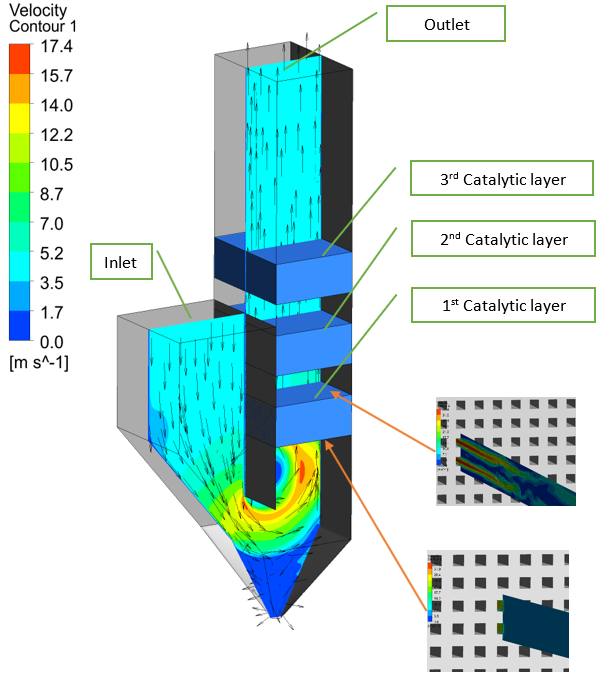Partner: ORGREZ
field: the energy industry
The company ORGREZ provides services and supplies in several fields of power and thermal engineering, generally in the processes of fuel energy conversion and electricity production and distribution. The Division for Ecology Systems deals with greenhouse gas issues and air protection technologies, both in terms of technologies for regulating and reducing pollutant emissions and systems for monitoring and evaluating pollutant emissions, especially CO2, NOX, and ash.
The objective of IT4Innovations was to determine whether Computational Fluid Dynamics (CFD) simulations could be used for both the fast and efficient description of the Selective Catalytic Reduction (SCR) process, and therefore as a tool to mediate the design of a computational application for the design of this technology. It belongs to the group of DeNOx technologies used to achieve the required reduction of the concentration of nitrogen oxides (NO, NO2, N2O) in the exhaust gases of combustion plants to the required level given by the applicable emission limits of specific combustion plants.
Numerical simulation of the SCR represents a complex definition of a given thermochemical process, for which one of the key issues is the definition of the inlet boundary conditions. CFD simulation of the combustion process and measured field data can be used as a source for these conditions’ parameters. The SCR model was tested on the geometry of a coal combustion boiler and project design data specified by the catalyst manufacturer, with a waste incineration boiler selected and municipal waste as the fuel. The CFD simulation resulted in a numerical description of the process of NOX concentration reduction, additional oxidation of CO to CO2, and conversion of SO2 to SO3. Currently, the design of the SCR plant is based on experience and simplified semi-empirical calculations. However, the use of numerical modelling and simulations will make the process more efficient and faster. Moreover, and most importantly, it will extend the application possibilities of the process, allowing subsequent optimisation of the designed solution and, thanks to high-performance computing, these simulations can be completed in a relatively short time.

PARTNER´S NOTE
Vojtěch Vavřička
Managing Director of the ORGREZ Division for Ecology Systems
“The cooperation with IT4Innovations confirmed the applicability of the CFD method in the design and optimisation of the SCR technology. By speeding up the design process of the SCR technology, time and cost savings are achieved and, in addition, the optimised SCR technology design leads to more effective NOX emission reduction and extended technology lifetime, which has a positive impact on the environment.”

This success story was supported by the EuroCC project. This project has received funding from the European High-Performance Computing Joint Undertaking (JU) under grant agreement No 951732. The JU receives support from the European Union’s Horizon 2020 research and innovation programme and Germany, Bulgaria, Austria, Croatia, Cyprus, the Czech Republic, Denmark, Estonia, Finland, Greece, Hungary, Ireland, Italy, Lithuania, Latvia, Poland, Portugal, Romania, Slovenia, Spain, Sweden, the United Kingdom, France, the Netherlands, Belgium, Luxembourg, Slovakia, Norway, Switzerland, Turkey, Republic of North Macedonia, Iceland, Montenegro. This project has received funding from the Ministry of Education, Youth and Sports of the Czech Republic (ID:MC2101).
